A worldwide success story started in a home garage.
An interview with New Zealand electronics entrepreneur Sir Peter Maire.
By Kevin Poulter.
Sir Peter Maire has a passionate interest in electronics. He’s reserved about accolades, including the honour bestowed on him by the Queen - his knighthood about the only time he has worn a suit. He is however excited and highly talented at developing products and companies.
His latest adventure is FUSION Electronics - suppliers of revolutionary Marine and Car Entertainment to the world. FUSION’s New Zealand designed marine head units are hailed as the ‘reinvention of Marine Entertainment’ and now their Car Entertainment Systems are making an impact.
I interviewed Peter at the Sanctuary Cove Boat Show in Australia, looking out from our vantage-point on a large Paddle-Steamer to a vista of boats, yachts and motor yachts, worth untold millions of dollars.
At the start, how did Navman marine become successful?
We knew digital navigation instruments were a winner, but were always concerned about cost, especially the platform. Whilst trying to decide on a cost-effective microprocessor we could use, we had had a look at the opposition products and they were all pretty conventional system components.
I happened to look at multi-function telephones that came out in the mid to late 80’s, with LCD displays and ‘millions’ of functions, really clever technology. So I said to Barry Gillard who was our one and only hardware and software engineer when we first started: ‘Barry what do you think of this funny telephone, it’s got a keypad LCD display, and does a lot more than any navigation instrument would do. I wonder if we should have a look.’
So we tore the bottom off and sure enough, there was one microprocessor which was built by a company called AKM or AsahiKASEI, still a major supplier of semiconductors.
We knew who the local agent was, so I asked for a data sheet and it was a chip designed for building millions of telephones, therefore very low in cost. We managed to persuade AKM in Japan to sell to us at a volume price and proceeded to make digital instruments. Over about five years we developed in the region of 60 different digital navigation instruments for speed, depth, wind, repeaters, fuel computer and the like. No-one could figure out how we made this huge price-break ahead of the rest of the industry, until they started taking our instruments apart and looking inside. Then it took them all a few years to catch up.
When did Navman start?
Originally the company was called Talon technology. Up until the mid 90's everything we built was for the US market and not using our own brand. We started looking at Europe and a big distributor had registered this wonderful brand name NAVMAN. We ended up doing a deal - we bought the brand for a dollar and gave them the distribution rights. It turned out to be a great brand and as the market slowly developed, we entered consumer navigation.
What about your University days?
I did Electronic Engineering and preceding that I was the guy who had the pirate radio station at home when I was a teenager - you do all those things - built guitar amplifiers and played in a rock and roll band, played around, built lots of loudspeakers. Then I worked in communications and manufacturing Hi-Fi. I had several companies, too many to mention, across all sorts of products - all with an electronic flavour, before starting the company that became Navman.
We also made induction cordless headphones for the education market, selling probably 100,000, under the brand Suntek. Later Suntek was my first marine electronics company too, selling instruments in Australia and New Zealand. Philips owned Marantz in Japan and Marantz was the largest shareholder of Standard communications USA (not GME Standard), our biggest customer in the US.
The induction loop headphone project was developed around 1980 and by about ’85 I was excited they sold in Australia and New Zealand. Later I sold my share to my partner and he went to the US to carry it on over there, resulting in a lot of product sold over a long period.
Did you sell Navman electronics before starting FUSION Electronics?
FUSION came later on. We sold Navman to Brunswick USA, then I took a small shareholding in FUSION and I bought twenty percent of Raycon New Zealand, publicly-listed it and Raycon is now a very large global company. (Brunswick has over 40 brands, mainly marine, however some readers may know of their Brunswick Ten-Pin bowling centres).
FUSION started in about 2000. The first time I saw the FUSION brand was at the annual CES (Consumer Electronic Show) in Las Vegas and had never heard of the company before. We were there with Navman showcasing navigation plus our normal GPS products and I walked into the automotive section. Here was a huge stand with model-babes everywhere and the guys had lime-green hair! I thought ‘wow this is a cool company, I have never seen this before’. The guys were talking in New Zealand accents, then I discovered who FUSION was.
In 2005 I bought a twenty percent shareholding. The guys had done a great job building the brand plus distribution, but areas like financial management were weak. I have now taken over the company and building it into the most innovative marine and car entertainment brand worldwide.
The future for FUSION?
Navigation has done really well in boats. At Navman we developed everything from a $50 digital sounder all the way up to Radar. Probably 10 years ago we said, ‘the world needs a great marine entertainment system - something that’s really designed for boats and not just modified car products. Not just a car radio painted white!’ Many brands modify their car products for marine, so the idea of buying into FUSION was to also use it as a platform for marine.
We started with the 500 series head units, then 600, however our new 200 series technology will be the platform for the future. It boasts a very powerful processor core - an ARM9 or ARM11 (we are currently using the ARM9 version), a new ST micro platform thats used being developed for the automotive industry.
What we plan to do is give the boat-owner the entertainment system he's always been looking for, instead of the hodge-podge of things that you see on large boats today. The 200 has the capabilities and is very iPod-centric, with USB functionality plus the fact that our products are truly marine with all diecast cases, marine environment-resistant and injection moulded parts, built similar to a navigation instrument.
I hear you spend a lot of time in the lab?
Yes, I have to say my passion in life is developing product, still enjoy it like the early days. All our products are designed in New Zealand and selling especially well, confirmed by unprecedented interest at international Shows.
We introduced a Marine Entertainment System that's years ahead of the others, with innovations like iPod and iPhone inside and optional iPad remote control. This 700 series suits boats from trailer size, through to Motor Yachts. We also released a new Car Audio range at the Consumer Electronics Show, to many accolades from people who saw them in operation.
Our culture includes: can-do, service, value, quality and point of difference. This achieves our goals - business is growing very strongly.
Click on the logo for the FUSION site
 |
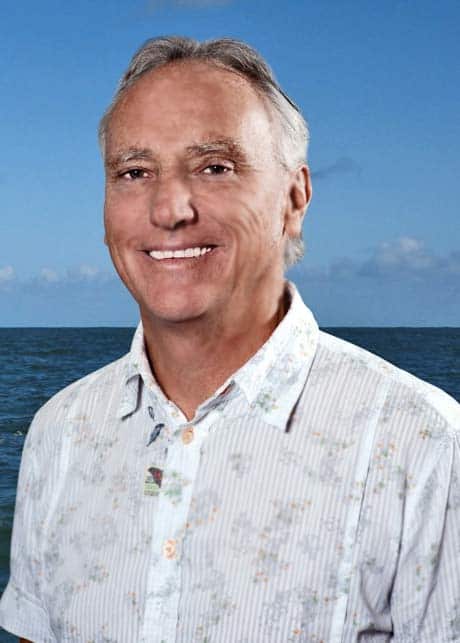
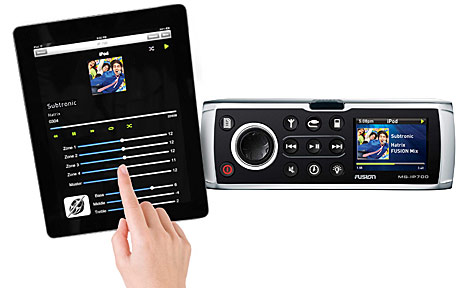

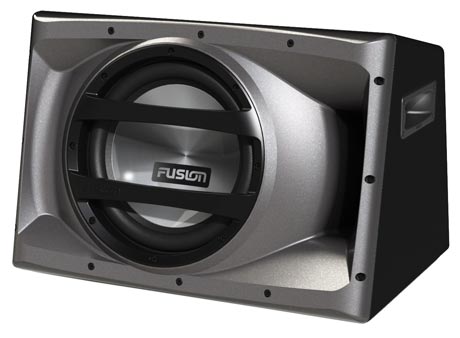
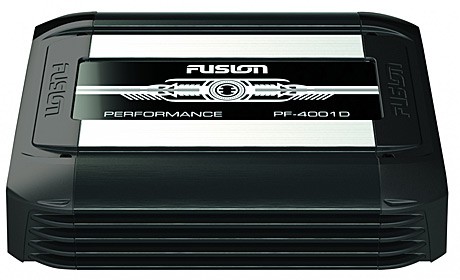
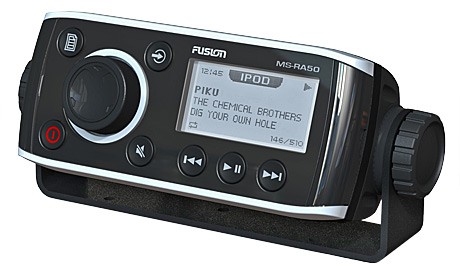 |


